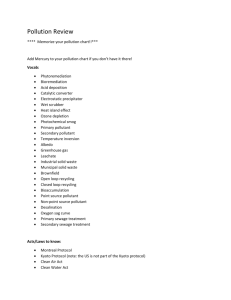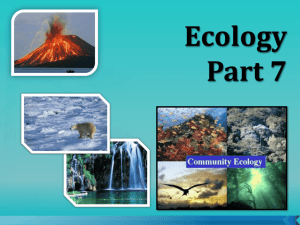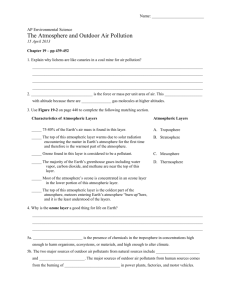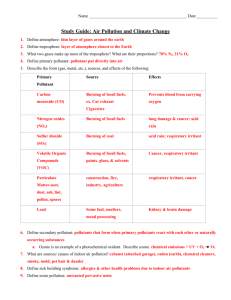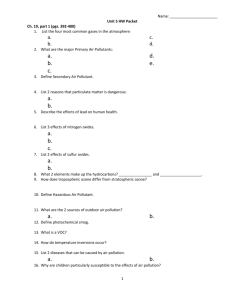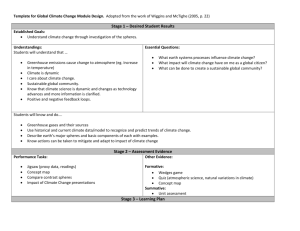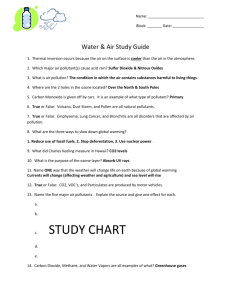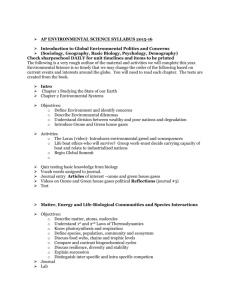Chapters 18-22
advertisement
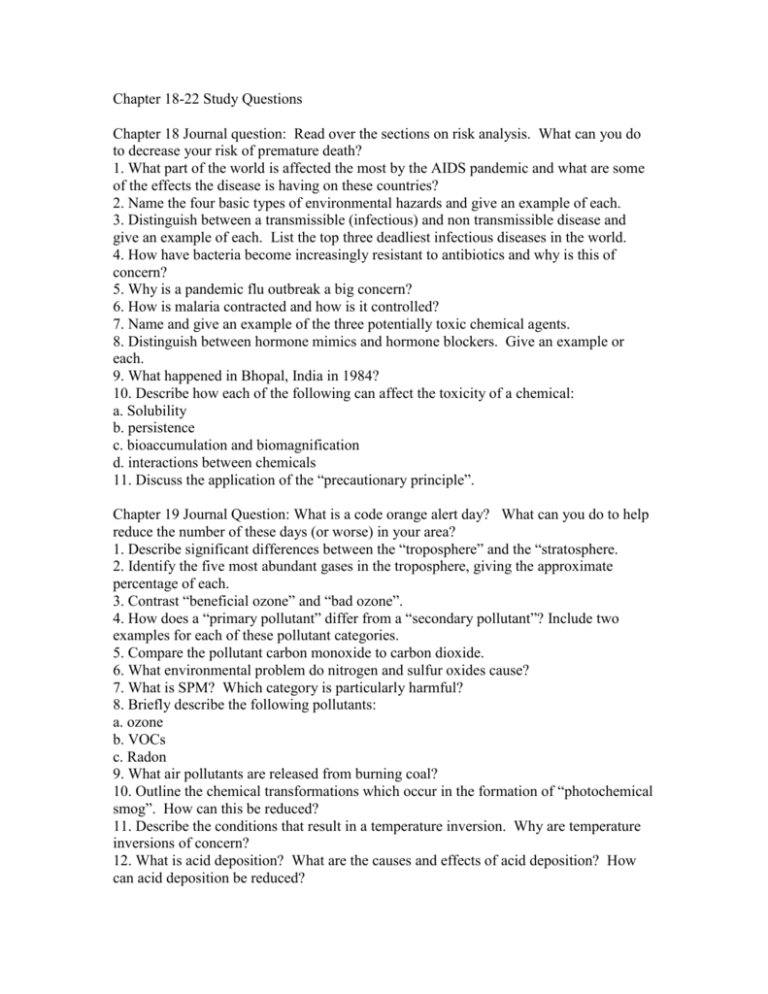
Chapter 18-22 Study Questions Chapter 18 Journal question: Read over the sections on risk analysis. What can you do to decrease your risk of premature death? 1. What part of the world is affected the most by the AIDS pandemic and what are some of the effects the disease is having on these countries? 2. Name the four basic types of environmental hazards and give an example of each. 3. Distinguish between a transmissible (infectious) and non transmissible disease and give an example of each. List the top three deadliest infectious diseases in the world. 4. How have bacteria become increasingly resistant to antibiotics and why is this of concern? 5. Why is a pandemic flu outbreak a big concern? 6. How is malaria contracted and how is it controlled? 7. Name and give an example of the three potentially toxic chemical agents. 8. Distinguish between hormone mimics and hormone blockers. Give an example or each. 9. What happened in Bhopal, India in 1984? 10. Describe how each of the following can affect the toxicity of a chemical: a. Solubility b. persistence c. bioaccumulation and biomagnification d. interactions between chemicals 11. Discuss the application of the “precautionary principle”. Chapter 19 Journal Question: What is a code orange alert day? What can you do to help reduce the number of these days (or worse) in your area? 1. Describe significant differences between the “troposphere” and the “stratosphere. 2. Identify the five most abundant gases in the troposphere, giving the approximate percentage of each. 3. Contrast “beneficial ozone” and “bad ozone”. 4. How does a “primary pollutant” differ from a “secondary pollutant”? Include two examples for each of these pollutant categories. 5. Compare the pollutant carbon monoxide to carbon dioxide. 6. What environmental problem do nitrogen and sulfur oxides cause? 7. What is SPM? Which category is particularly harmful? 8. Briefly describe the following pollutants: a. ozone b. VOCs c. Radon 9. What air pollutants are released from burning coal? 10. Outline the chemical transformations which occur in the formation of “photochemical smog”. How can this be reduced? 11. Describe the conditions that result in a temperature inversion. Why are temperature inversions of concern? 12. What is acid deposition? What are the causes and effects of acid deposition? How can acid deposition be reduced? 13. What is the “Sick Building Syndrome”? Describe ways that this can be cleaned up. 14. Describe three types of indoor air pollution and suggest ways to prevent each of them. 15. Describe the ramifications of the Clean Air Acts of 1970, 1977 and 1990. Chapter 20 Journal question: This chapter deals with the greenhouse effect and ozone depletion. Both of these problems are considered to be “global” environmental problems. What special considerations exist with problems that are global in scope? 1. Describe “the greenhouse effect” and what the earth would be like without any greenhouse gases. 2. List the major greenhouse gases. Which have been increasing as a result of human activity? Which human activities have increased these gases? 3. Describe the evidence that scientists cite that the troposphere is warming. 4. What effects would a warmer Earth have on our ecosystem? 5. Discuss the effects of two of the following on the earth’s temperature. If appropriate, mention if positive or negative feedback is involved in the process. a. carbon sequestering in the oceans b. cloud cover c. outdoor air pollution d. photosynthesis e. release of methane by the permafrost in the artic tundra 6. Describe the effects of a warmer climate on three of the following: a. ice and snow b. sea levels c. ocean currents d. sea temperature and pH e. precipitation patterns and weather extremes f. biodiversity g. agriculture h. people 7. What are some solutions to climate change? 8. What is the Kyoto Protocol? What is the position of our country on the protocol? 9. What is the importance of stratospheric ozone? What is causing this protective layer to decrease? What evidence do we have that the ozone layer is depleting? 10. What human heath effects are resulting from decrease ozone? What can we do to prevent ozone depletion? What can we do to protect ourselves from the harmful uV ? Chapter 21 Journal question What can you do to reduce water pollution in your area? 1. Compare point and non-point sources of water pollution. 2. Describe three of the following types of water pollutants: a. infectious agents b. BOD (biological oxygen demanding wastes) c. plant nutrients d. organic chemicals e. inorganic chemicals f. sediment g. thermal pollution 3. Sketch the “oxygen sag curve”. Show both DO (dissolved oxygen) and BOD (biological oxygen demand) on your graph 4. Compare stream pollution in developed countries to that in developing countries. 5. Discuss the problems of the Ganges River in India. 6. What is cultural eutrophication and what effects does it have on lakes? 7. What are major sources groundwater pollution and how can groundwater pollution be prevented? 8. Is the ocean too big to be polluted by human activities? Explain your answer. 9. What problems are occurring in the Chesapeake Bay and what is being done to correct the situation? 10. Why is the oxygen being depleted in the northern Gulf of Mexico? 11. What can be done to prevent and cleanup oil spills in the ocean like the Exxon Valdez accident in Alaska’s Prince William Sound in 1989 and the blow out of the Deepwater Horizon oil rig in the Gulf of Mexico in 2010? 12. What are the major provisions of the Clean Water Act? 13. How does a septic tank treat wastes? 14. Describe the three levels of sewage treatment used in most municipal treatment plants. 15. How is municipal drinking water treated before it is distributed to the users? Chapter 22 Journal question. Research and locate a superfund site within 100 miles of your home. Where is the site that you found? What environmental damage was done at this site and what is being done to address the situation? 1. Briefly describe what happened in Love Canal, New York in the middle of the 20th century. 2. What is the “superfund” law? 3. What are the three main types of solid waste? 4. Why do you think that the US with only 4.6% of the population produces 33% of the world’s solid waste? 5. What is e-waste and why is it particularly hazardous? 6. What is integrated waste management and what are the three priorities used in this approach. 7. Describe each of the five R’s of waste reduction. Give an example of how you can implement each of these R’s in your everyday life. 8. What are the advantages and disadvantages of burning as compared to burying solid wastes? 9. What is hazardous waste and how should it be dealt with? 10. Why is the abundance of lead and mercury in the environment of concern and what should be done about these heavy metals? 11. What do you suggest should be done to move our country to become a low waste society?

